World War I

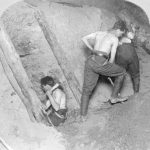 World War I found the British Army with a big problem. The German 4th Army was deeply entrenched at Messines Ridge in northern France, and the British had to remove them…somehow. The British came up with a plan, and for the 18 months prior to June 7, 1917, soldiers had been secretly working to place nearly 1 million pounds of explosives in tunnels under the German positions. The tunnels extended to some 2,000 feet in length, and some were as much as 100 feet below the surface of the ridge, where the German stronghold positions were located. The plan was put into action by the British 2nd Army under the supervision of General Sir Herbert Plumer. The joint explosion of the mines at Messines ranks among the largest non-nuclear explosions of all time. The evening before the attack, General Sir Charles Harington, Chief of Staff of the Second Army, remarked to the press, “Gentlemen, I don’t know whether we are going to make history tomorrow, but at any rate we shall change geography”.
World War I found the British Army with a big problem. The German 4th Army was deeply entrenched at Messines Ridge in northern France, and the British had to remove them…somehow. The British came up with a plan, and for the 18 months prior to June 7, 1917, soldiers had been secretly working to place nearly 1 million pounds of explosives in tunnels under the German positions. The tunnels extended to some 2,000 feet in length, and some were as much as 100 feet below the surface of the ridge, where the German stronghold positions were located. The plan was put into action by the British 2nd Army under the supervision of General Sir Herbert Plumer. The joint explosion of the mines at Messines ranks among the largest non-nuclear explosions of all time. The evening before the attack, General Sir Charles Harington, Chief of Staff of the Second Army, remarked to the press, “Gentlemen, I don’t know whether we are going to make history tomorrow, but at any rate we shall change geography”.
On June 7, 1917, they were ready to carry out their secret attack. The explosions created 19 large craters. It would be a crushing victory over the Germans who had no idea of the impending disaster they were about to face. This attack would mark the successful beginning of an Allied offensive designed to break the grinding stalemate on the Western Front in World War I. The time of the attack was set for 3:10am. Precisely on schedule, a series of simultaneous explosions rocked the area. The blast from the detonation of all those landmines was heard as far away as London. A German observer described the explosions, “nineteen gigantic roses with carmine petals, or enormous mushrooms, rose up slowly and majestically out of the ground and 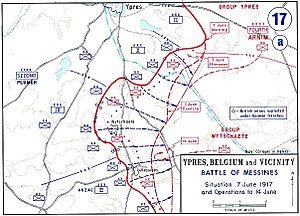
 then split into pieces with a mighty roar, sending up multi-colored columns of flame mixed with a mass of earth and splinters high in the sky.” German losses that day included more than 10,000 men who died instantly, along with some 7,000 prisoners…men too stunned and disoriented by the explosions to resist the infantry assault.
then split into pieces with a mighty roar, sending up multi-colored columns of flame mixed with a mass of earth and splinters high in the sky.” German losses that day included more than 10,000 men who died instantly, along with some 7,000 prisoners…men too stunned and disoriented by the explosions to resist the infantry assault.
Although Messines Ridge battle was, itself was a relatively limited victory, it had a considerable effect on the German morale. The Germans were forced to retreat to the east, a sacrifice that marked the beginning of their gradual, but continuous loss of territory on the Western Front. It also secured the right flank of the British thrust towards the highly contested Ypres region, which was the eventual objective of the planned offensive. Over the next month and a half, British forces continued to push the Germans back toward the high ridge at Passchendaele, which on July 31 saw the launch of the British offensive known as the Battle of Passchendaele. The Battle of Messines marked the high point of mine warfare. On August 10, 1917, the Royal Engineers fired the last British deep mine of the war, at Givenchy-en-Gohelle near Arras.
The explosions left a mine crater 40 feet deep. The attack had done its job. Still, after the war was over, the crater remained, and some wanted to change the “feel” of the place. Nowadays, this mine crater is a serene, contemplative place. I’m sure that many who visit there feel the significance of the location, but also know just  how necessary it was to ensure the freedom of France from the tyranny of the German forces. Named The Pool of Peace, it is a 40 foot deep lake near Messines, Belgium. It fills one of the craters made in 1917 when the British detonated a mine containing 45 tons of explosives. The pool stretches 423 feet across, and remains a place of solace that receives many visitors every year. It seems to me that, while most of those killed in the mine fields on June 7, 1917, were Germans, and therefore, the enemy, they were also people, many of whom didn’t want to be there any more than the Allies did. They were there under orders, and that was all there was to it. For that reason, I believe that place should be, finally, a place of peace.
how necessary it was to ensure the freedom of France from the tyranny of the German forces. Named The Pool of Peace, it is a 40 foot deep lake near Messines, Belgium. It fills one of the craters made in 1917 when the British detonated a mine containing 45 tons of explosives. The pool stretches 423 feet across, and remains a place of solace that receives many visitors every year. It seems to me that, while most of those killed in the mine fields on June 7, 1917, were Germans, and therefore, the enemy, they were also people, many of whom didn’t want to be there any more than the Allies did. They were there under orders, and that was all there was to it. For that reason, I believe that place should be, finally, a place of peace.
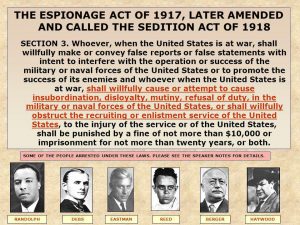 It seems strange to me to create a piece of legislation that protects the government and the war effort from…basically hate speech, but on May 16, 1918, the United States Congress did pass just such an act. What seems even more strange is to have a need for such a piece of legislation during a time of war. Called the Sedition Act, a piece of legislation designed to protect America’s participation in World War I. Along with the Espionage Act of the previous year, the Sedition Act was orchestrated largely by A. Mitchell Palmer, the United States attorney general under President Woodrow Wilson. I think most of us understand espionage, and why such an act was important to the war effort. The Espionage Act, passed shortly after the US entrance into the war in early April 1917, made it a crime for any person to convey information intended to interfere with the U.S. armed forces’ prosecution of the war effort or to promote the success of the country’s enemies.
It seems strange to me to create a piece of legislation that protects the government and the war effort from…basically hate speech, but on May 16, 1918, the United States Congress did pass just such an act. What seems even more strange is to have a need for such a piece of legislation during a time of war. Called the Sedition Act, a piece of legislation designed to protect America’s participation in World War I. Along with the Espionage Act of the previous year, the Sedition Act was orchestrated largely by A. Mitchell Palmer, the United States attorney general under President Woodrow Wilson. I think most of us understand espionage, and why such an act was important to the war effort. The Espionage Act, passed shortly after the US entrance into the war in early April 1917, made it a crime for any person to convey information intended to interfere with the U.S. armed forces’ prosecution of the war effort or to promote the success of the country’s enemies.
The Sedition Act was aimed at socialists, pacifists and other anti-war activists. The Act imposed harsh penalties on anyone who was found guilty of making false statements that interfered with the prosecution of the war; insulting or abusing the United States government, the flag, the Constitution or the military; agitating against the production of necessary war materials; or advocating, teaching or defending any of these acts. Hmmm…I think we have need of this act in today’s America. Those who were found guilty of such actions, would according to the Sedition Act be punished by a fine of not more than $10,000 or imprisonment for not more than twenty years, or both. The penalty was the same as the one for acts of espionage in the earlier legislation.
Though Wilson and Congress considered the Sedition Act as crucial in order to stifle the spread of dissent within the country in that time of war, modern legal scholars felt the act was contrary to the letter and spirit of the US Constitution, specifically to the First Amendment of the Bill of Rights. One of the most famous prosecutions under the Sedition Act during World War I was that of Eugene V. Debs, a pacifist labor organizer and founder of the International Workers of the World (IWW Debs had run for president in 1900 as a Social Democrat and in 1904, 1908 and 1912 on the Socialist Party of America ticket. He delivered an anti-war speech in June 1918 in Canton, Ohio and was promptly arrested. After being found guilty, he was sentenced to ten years in prison under the Sedition Act. Debs appealed the decision and upon stating that Debs had acted with the intention of obstructing the war effort the US Supreme Court upheld his conviction.
Chief Justice Oliver Wendell Holmes referred to the earlier landmark case of Schenck v. United States (1919) as the basis for his decision. Charles Schenck, also a Socialist, had been found guilty under the Espionage Act after distributing a flyer urging recently drafted men to oppose the United States conscription policy. Holmes stated that freedom of speech and press could be constrained in certain instances. He said that the question in every case is “whether the words used are used in such circumstances and are of such a nature as to create a clear and present danger that they will bring about the substantive evils that Congress has a right to prevent.”
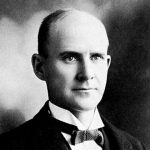
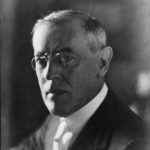
Debs’ sentence was commuted in 1921 when the Sedition Act was repealed by Congress. Major portions of the Espionage Act remain part of United States law to the present day, although the crime of sedition was largely eliminated by the famous libel case Sullivan v. New York Times (1964), which determined that “the press’s criticism of public officials—unless a plaintiff could prove that the statements were made maliciously or with reckless disregard for the truth—was protected speech under the First Amendment.”
 The leaders of wars have long been known for their means of deception. They will try whatever they can to confuse the enemy, and thus make their own troops safer. It all seems like a good idea, until it all goes wrong. Such was the case when, during World War I, the British army decided to disguise a passenger ship…the RMS Carmania into a battleship disguised as another passenger ship…the German SMS Trafalgar.
The leaders of wars have long been known for their means of deception. They will try whatever they can to confuse the enemy, and thus make their own troops safer. It all seems like a good idea, until it all goes wrong. Such was the case when, during World War I, the British army decided to disguise a passenger ship…the RMS Carmania into a battleship disguised as another passenger ship…the German SMS Trafalgar.
Now that all seems like a good plan, provided that you don’t run into the real SMS Trafalgar…or someone who knows where the real SMS Trafalgar is at that moment. The plan was working well, and the RMS Carmania/SMS Trafalgar seemed a great success. The only problem was that the Germans had the same idea. They decided to disguise the SMS Trafalgar as the RMS Carmania. It is odd that each side chose the ship that the other had disguised, and when you think about it, it was clearly a recipe for disaster. It was only a matter of time before the two ships would run into each other, each knowing that the other was an imposter, but not knowing that their enemy knew the same thing.
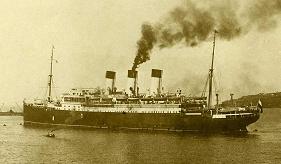
The unavoidable encounter came on September 14, 1914. A fierce battle ensued, and in the end, it was the SMS Trafalgar turned RMS Carmania that would ultimately lose this battle. In all, 51 men were killed and 279 injured from the real SMS Trafalgar, while the real RMS Carmania suffered just 9 losses. The SMS Trafalgar was also lost in the encounter. While the real RMS Carmania suffered repairable damage. The battle and ultimate sinking of the SMS Trafalgar took place off the coast of Brazil. I find it quite ironic that each ship was trying to hide in plain sight, and ended up in a battle with the very ship it was disguised to look like.
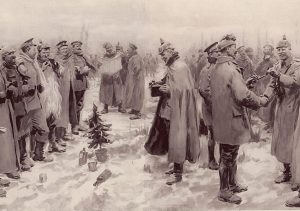 It was 1914, and World War I was in the 5th month of a 51 month offensive. The war effort was in a bit of a transition period, following the stalemate of the Race to the Sea and the indecisive result of the First Battle of Ypres. As leadership on both sides reconsidered their strategies, hostilities entered a bit of a lull. The men were hoping for a break in the action for Christmas that year, but they had to wait for their orders. When the orders came down, it was not to be a Christmas truce, but rather a Christmas strike. As the first men to go forth prepared to make the first advances, some men were killed, and some returned. It was the way of war. The leadership wanted to take advantage of the possibility that the enemy might not expect a Christmas attack. One of the younger men…17 years old to be exact, couldn’t help himself. He began to sing Silent Night.His superiors ordered it to be quiet. They feared that the enemy was waiting in the darkness.
It was 1914, and World War I was in the 5th month of a 51 month offensive. The war effort was in a bit of a transition period, following the stalemate of the Race to the Sea and the indecisive result of the First Battle of Ypres. As leadership on both sides reconsidered their strategies, hostilities entered a bit of a lull. The men were hoping for a break in the action for Christmas that year, but they had to wait for their orders. When the orders came down, it was not to be a Christmas truce, but rather a Christmas strike. As the first men to go forth prepared to make the first advances, some men were killed, and some returned. It was the way of war. The leadership wanted to take advantage of the possibility that the enemy might not expect a Christmas attack. One of the younger men…17 years old to be exact, couldn’t help himself. He began to sing Silent Night.His superiors ordered it to be quiet. They feared that the enemy was waiting in the darkness.
Then, a miracle occurred. In the week leading up to the 25th of December, French, German, and British soldiers crossed trenches to exchange seasonal greetings…and to talk. In some areas, men from both sides ventured into what was called no man’s land, because to go there was to risk death. Nevertheless, on that Christmas Eve and Christmas Day, things seemed different. The soldiers took a chance and stepped forward, hoping to convince their enemies that they only wanted to bury their dead, and hoping that it would be 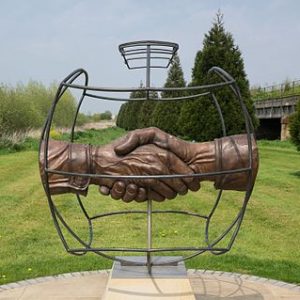 agreeable to stop the fighting for one hour to bury the dead. As they buried their dead, with heavy hearts, someone suggested that they take Christmas Day off. This was totally against their orders, and they knew that at some point they were going to have to go back and follow their orders. They were going to have to become enemies again. Still, for now…for this day, they mingled and exchange food and souvenirs. There were joint burial ceremonies and prisoner swaps. Men played games of football with one another, giving one of the most memorable images of the truce. Peaceful behavior was not ubiquitous, however, and fighting continued in some sectors, while in others the sides settled on little more than arrangements to recover bodies. Several meetings ended in carol-singing. Someone commented, “How many times in a life do you actually meet your enemy face to face.” It was almost strange to them, because these “enemies” were not the monsters they expected them to be. These were simply men, just like they were. I’m sure the men were in shock. it’s hard to have your total view of your enemy change so drastically and then have to follow your orders, pickup your weapons, and shoot at the same men again. The Christmas truce (German: Weihnachtsfrieden; French: Trêve de Noël) was a series of widespread but unofficial ceasefires along the Western Front of World War I around Christmas 1914.
agreeable to stop the fighting for one hour to bury the dead. As they buried their dead, with heavy hearts, someone suggested that they take Christmas Day off. This was totally against their orders, and they knew that at some point they were going to have to go back and follow their orders. They were going to have to become enemies again. Still, for now…for this day, they mingled and exchange food and souvenirs. There were joint burial ceremonies and prisoner swaps. Men played games of football with one another, giving one of the most memorable images of the truce. Peaceful behavior was not ubiquitous, however, and fighting continued in some sectors, while in others the sides settled on little more than arrangements to recover bodies. Several meetings ended in carol-singing. Someone commented, “How many times in a life do you actually meet your enemy face to face.” It was almost strange to them, because these “enemies” were not the monsters they expected them to be. These were simply men, just like they were. I’m sure the men were in shock. it’s hard to have your total view of your enemy change so drastically and then have to follow your orders, pickup your weapons, and shoot at the same men again. The Christmas truce (German: Weihnachtsfrieden; French: Trêve de Noël) was a series of widespread but unofficial ceasefires along the Western Front of World War I around Christmas 1914.
The Christmas Truces of 1914, while wonderful for the men, were not to be a Christmas tradition in World War I. The following year, a few units arranged ceasefires but the truces were not nearly as widespread as in 1914.  This was, in part, due to strongly worded orders from the high commands of both sides prohibiting truces. It was evident that while the mini-mutiny of 1914 was tolerated and the men were not punished, that this would not be tolerated in the future. It really didn’t matter, because the Soldiers were no longer amenable to truce by 1916. The war had become increasingly bitter after devastating human losses suffered during the battles of the Somme and Verdun, and the use of poison gas. While a Christmas truce would be nice in theory, bitter and angry feelings on both sides of a war make it an impractical idea. Still, in 1914, the miracle of the Christmas Truce was a wonderful treat for the men on all sides of a bitter war.
This was, in part, due to strongly worded orders from the high commands of both sides prohibiting truces. It was evident that while the mini-mutiny of 1914 was tolerated and the men were not punished, that this would not be tolerated in the future. It really didn’t matter, because the Soldiers were no longer amenable to truce by 1916. The war had become increasingly bitter after devastating human losses suffered during the battles of the Somme and Verdun, and the use of poison gas. While a Christmas truce would be nice in theory, bitter and angry feelings on both sides of a war make it an impractical idea. Still, in 1914, the miracle of the Christmas Truce was a wonderful treat for the men on all sides of a bitter war.
 When people think of plastic surgery, the mind congers up images of everything from severe scar repair to vanity surgeries, but who originally came up with these procedures. Although the development of plastic surgery is popularly believed to have taken place in modern times, the origins of plastic surgery are very old. In the early part of the 1400s, the nose received the most attention from the early plastic surgeons. One of the first procedures for reconstructing the nose, a primitive precursor to the nose job, is attributed to a surgeon called Antonio Branca.
When people think of plastic surgery, the mind congers up images of everything from severe scar repair to vanity surgeries, but who originally came up with these procedures. Although the development of plastic surgery is popularly believed to have taken place in modern times, the origins of plastic surgery are very old. In the early part of the 1400s, the nose received the most attention from the early plastic surgeons. One of the first procedures for reconstructing the nose, a primitive precursor to the nose job, is attributed to a surgeon called Antonio Branca.
After that era, Plastic surgery had to wait until the late 18th century for the next significant advance in its history…the skin graft. And ironically the breakthrough came from rediscovering a procedure developed in ancient India. The severe-looking skin graft procedure was rediscovered in an ancient book called the “Sushruta Samhita,” dating back to 8th century BC. There hidden in the book’s 184 chapters was a technique using a leaf-shaped flap from the forehead to  reconstruct the nose. The technique was published in the ‘Gentleman’s Magazine of Calcutta’ in October 1794 and it soon became widely used. It was known as the “Indian Method”.
reconstruct the nose. The technique was published in the ‘Gentleman’s Magazine of Calcutta’ in October 1794 and it soon became widely used. It was known as the “Indian Method”.
While these methods undoubtedly had a great impact on the history of plastic surgery, it would be another event that would have one of the biggest impacts on plastic surgery, and its methodology. That event was World War I. Shrapnel was the cause of many facial injuries during world War I, and unlike the straight-line wounds inflicted by bullets, the twisted metal shards produced from a shrapnel blast could easily rip a face off. Harold Gillies, a surgeon, was horrified by the injuries he saw, and he immediately took on the task of helping these victims. He saw these men as more than victims. They were heroes, and that’s how he saw them. He knew he had to do something to help these men get back to a normal life. So, he pioneered early techniques of facial reconstruction in the process.
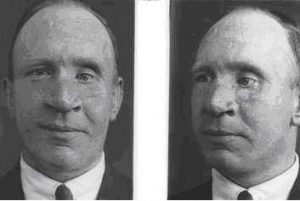 While these were great advances, it’s likely that the most significant improvements in the history of plastic surgery occurred in the last century. Several plastic surgery techniques were introduced during the world wars. Skin grafting techniques such as the “tubed pedicled graft,” were state of the art during World War I. Archibald McIndoe and Harold Gillies refined the techniques to treat severe facial burns. These staged procedures differed from earlier plastic surgery because they relied on the growth and development of a blood supply from the recipient bed into the grafted tissue over many weeks or months. While that all seems pretty normal these days, it was unheard of until then.
While these were great advances, it’s likely that the most significant improvements in the history of plastic surgery occurred in the last century. Several plastic surgery techniques were introduced during the world wars. Skin grafting techniques such as the “tubed pedicled graft,” were state of the art during World War I. Archibald McIndoe and Harold Gillies refined the techniques to treat severe facial burns. These staged procedures differed from earlier plastic surgery because they relied on the growth and development of a blood supply from the recipient bed into the grafted tissue over many weeks or months. While that all seems pretty normal these days, it was unheard of until then.
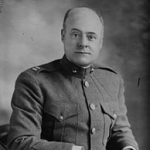 Anthony Joseph Drexel Biddle I (1874–1948) was an eccentric millionaire whose fortune allowed him to pursue theatricals, self-published writing, athletics, and Christianity on a full-time basis. He was the man upon whom the book “My Philadelphia Father” and the play and film “The Happiest Millionaire” were based, but even before that Biddle was eccentric…to say the least. Biddle was a trainer in hand-to-hand combat in both World War I and World War II. In fact, Biddle was an expert in hand-to-hand combat. He also had an unusual way of training his men. It was not unusual for Biddle to tell his trainees to attempt to kill him!! I can’t say for sure that he allowed them to use live ammunition, but he did give them “chance” to try to kill him before he could disarm them.
Anthony Joseph Drexel Biddle I (1874–1948) was an eccentric millionaire whose fortune allowed him to pursue theatricals, self-published writing, athletics, and Christianity on a full-time basis. He was the man upon whom the book “My Philadelphia Father” and the play and film “The Happiest Millionaire” were based, but even before that Biddle was eccentric…to say the least. Biddle was a trainer in hand-to-hand combat in both World War I and World War II. In fact, Biddle was an expert in hand-to-hand combat. He also had an unusual way of training his men. It was not unusual for Biddle to tell his trainees to attempt to kill him!! I can’t say for sure that he allowed them to use live ammunition, but he did give them “chance” to try to kill him before he could disarm them.
An officer in the United States Marine Corps, Biddle was an expert in close-quarters fighting and the author of “Do or Die: A Supplementary Manual on Individual Combat,” a book on combat methods, including knives and empty-hand skills, training both the United States Marine Corps in two world wars and Special Agents of the Federal Bureau of Investigation. He was considered not just an expert in fighting, but also a pioneer of United States Marine Corps training in the bayonet and hand-to-hand combat. He based his style on fencing, though this approach was sometimes criticized as being unrealistic for military combat. At one point, when it looked like there was no way out of a drill he assigned to his men…they were surrounding him, and for all intents and 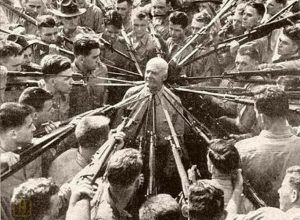 purposes, they had him. Nevertheless, the outcome was not what anyone would have expected, because within in a few minutes, Biddle had completely disarmed each and every one of the men.
purposes, they had him. Nevertheless, the outcome was not what anyone would have expected, because within in a few minutes, Biddle had completely disarmed each and every one of the men.
Born on October 1, 1874 in Philadelphia, Pennsylvania, to Edward Biddle II and Emily Drexel, Anthony was grandson of banker Anthony Joseph Drexel, and great-grandson of banker Nicholas Biddle. Biddle was a graduate of Germany’s Heidelberg University. He was a fellow of the American Geographical Society and founded a movement called “Athletic Christianity” that eventually attracted 300,000 members around the world. A 1955 Sports Illustrated article called him “boxing’s greatest amateur” as well as a “major factor in the re-establishment of boxing as a legal and, at that time, estimable sport.” He joined the Marines in 1917 at the age of 41, and convinced his superiors to include boxing in Marine Corps recruit training. In 1919, he was promoted to the rank of major, and became a lieutenant colonel in 1934. In Lansdowne, Pennsylvania, right outside of Philadelphia, Biddle opened a military training facility, where he trained 4,000 men. His training included long hours of calisthenics and gymnastics, and taught skills such as machete, saber, dagger, bayonet combat, hand grenade use, boxing, wrestling, savate and jiujitsu. He also served two years in the National Guard.
 In 1895, he married Cordelia Rundell Bradley. Their marriage was blessed with three children, Anthony Joseph Drexel Biddle Jr. (1897–1961), who married Mary Duke (1887–1960). They were the parents of Mary Duke Biddle (1920–2012) and Nicholas Benjamin Duke Biddle. Their second child was Cordelia Drexel Biddle (1898–1984), who married Angier Buchanan Duke (1884–1923), the son of Benjamin Newton Duke. They were the parents of Angier Biddle Duke (1915–1995) and Anthony Drexel Duke (1918-2014). Their third child was Livingston Ludlow Biddle (1899–1981), who married Kate Raboteau Page (b. 1903), daughter of Robert N. Page. They were the parents of Livingston Ludlow Biddle III. Biddle died May 27, 1948 from a cerebral hemorrhage and uremic poisoning.
In 1895, he married Cordelia Rundell Bradley. Their marriage was blessed with three children, Anthony Joseph Drexel Biddle Jr. (1897–1961), who married Mary Duke (1887–1960). They were the parents of Mary Duke Biddle (1920–2012) and Nicholas Benjamin Duke Biddle. Their second child was Cordelia Drexel Biddle (1898–1984), who married Angier Buchanan Duke (1884–1923), the son of Benjamin Newton Duke. They were the parents of Angier Biddle Duke (1915–1995) and Anthony Drexel Duke (1918-2014). Their third child was Livingston Ludlow Biddle (1899–1981), who married Kate Raboteau Page (b. 1903), daughter of Robert N. Page. They were the parents of Livingston Ludlow Biddle III. Biddle died May 27, 1948 from a cerebral hemorrhage and uremic poisoning.
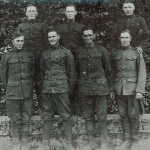 This day…Armistice Day was sometimes called the end of the war to end all wars. The phrase came from a book, and was really an idealistic statement, because as we all know there will always be a war somewhere. Nevertheless, it must have been overwhelming to think of basically the whole world at war. I’m sure the writer of the book, H G Wells, as well as many other people, hoped that through this awful war, humans could somehow learn to live with one another in peace. While that was not to be, this war, like every war, finally comes to an end. Armistice Day marks the armistice signed between the Allies of World War I and Germany at Compiègne, France, for the cessation of hostilities on the Western Front of World War I, which took effect at eleven o’clock in the morning, on the “eleventh hour of the eleventh day of the eleventh month” of 1918. That was, of course, 100 years ago today. Armistice Day is a national holiday in France. It coincides with Remembrance Day in England, and Veterans Day in the United States, and all three are really commemorating the same thing…the end of World War I. And all three are observed as a time to remember those heroes who served their country in that and all other wars. It is a day to remember those who fought and
This day…Armistice Day was sometimes called the end of the war to end all wars. The phrase came from a book, and was really an idealistic statement, because as we all know there will always be a war somewhere. Nevertheless, it must have been overwhelming to think of basically the whole world at war. I’m sure the writer of the book, H G Wells, as well as many other people, hoped that through this awful war, humans could somehow learn to live with one another in peace. While that was not to be, this war, like every war, finally comes to an end. Armistice Day marks the armistice signed between the Allies of World War I and Germany at Compiègne, France, for the cessation of hostilities on the Western Front of World War I, which took effect at eleven o’clock in the morning, on the “eleventh hour of the eleventh day of the eleventh month” of 1918. That was, of course, 100 years ago today. Armistice Day is a national holiday in France. It coincides with Remembrance Day in England, and Veterans Day in the United States, and all three are really commemorating the same thing…the end of World War I. And all three are observed as a time to remember those heroes who served their country in that and all other wars. It is a day to remember those who fought and 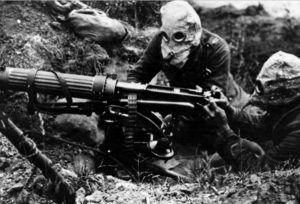 then returned home, but we can’t forget those who didn’t return home either.
then returned home, but we can’t forget those who didn’t return home either.
Because World War I ended on November 11, 1918, we have continued to remember November 11 as Veterans Day, Armistice Day, and Remembrance Day in honor of our soldiers. The armistice initially expired after a period of 36 days. A formal peace agreement was only reached when the Treaty of Versailles was signed the following year, but the Armistice was the beginning. It paved the way, and sometimes that is what is needed the most at a certain low time in history, or in life. Just a glimmer of hope can change the way we feel about things in a big way. It doesn’t matter what name is attached to the day, its all about the meaning of the day that matters. Our veterans have done so much for people they don’t even know, and they all deserve to be recognized for their very heroic acts.
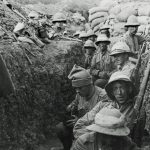 The date is a national holiday in France, England, the United States, and was also declared a national holiday in many Allied nations. In some countries Armistice Day coincides with Remembrance Day and Veterans Day, and other public holidays. Armistice Day is not celebrated in Germany, but a German national day of mourning, Volkstrauertag, has been observed on the Sunday closest to 16 November since 1952. However the day is observed, it is always a day to remember the sacrifice of our soldiers. The day is always celebrated as a day to honor those who served. We can all relate to that, because we all know a veteran, and we all consider them to be honorable people. So, no matter how each country celebrates it or what they call it, we honor our veterans today. Happy Veterans Day!!
The date is a national holiday in France, England, the United States, and was also declared a national holiday in many Allied nations. In some countries Armistice Day coincides with Remembrance Day and Veterans Day, and other public holidays. Armistice Day is not celebrated in Germany, but a German national day of mourning, Volkstrauertag, has been observed on the Sunday closest to 16 November since 1952. However the day is observed, it is always a day to remember the sacrifice of our soldiers. The day is always celebrated as a day to honor those who served. We can all relate to that, because we all know a veteran, and we all consider them to be honorable people. So, no matter how each country celebrates it or what they call it, we honor our veterans today. Happy Veterans Day!!
 During World War I, Britain, like the United States would have to do in World War II, had to employ large numbers of women into jobs vacated by men who had gone to fight in the war. They also had to create new jobs as part of the war effort. As an example, women were hired in munitions factories. The high demand for weapons resulted in the munitions factories becoming the largest single employer of women during 1918. It was a job that many people resisted, mainly because it was seen as “men’s work.” When I think about the work these women were doing, I find myself much more concerned with the toxicity and danger of the materials they were working with, than whether or not the job should be done by a man. Of course, the materials would present the same danger to the men, but the men had always felt like the dangerous work should fall to them.
During World War I, Britain, like the United States would have to do in World War II, had to employ large numbers of women into jobs vacated by men who had gone to fight in the war. They also had to create new jobs as part of the war effort. As an example, women were hired in munitions factories. The high demand for weapons resulted in the munitions factories becoming the largest single employer of women during 1918. It was a job that many people resisted, mainly because it was seen as “men’s work.” When I think about the work these women were doing, I find myself much more concerned with the toxicity and danger of the materials they were working with, than whether or not the job should be done by a man. Of course, the materials would present the same danger to the men, but the men had always felt like the dangerous work should fall to them.
Nevertheless, with the introduction of conscription in 1916 everything changed. Conscription refers to the process of automatically calling up men and women for military service. During the First World War men (it only applied to men at this time) who were conscripted into the armed forces had no choice but to go and fight, even if they did not want to. Around 1916, with the need becoming serious, the government began  coordinating the employment of women through campaigns and recruitment drives. This led to women working in areas of work that were formerly reserved for men. Jobs such as, for example railway guards, ticket collectors, buses, tram conductors, postal workers, police, firefighters, as well as bank tellers and clerks. Some women also worked heavy or precision machinery in engineering, led cart horses on farms, and worked in the civil service and factories.
coordinating the employment of women through campaigns and recruitment drives. This led to women working in areas of work that were formerly reserved for men. Jobs such as, for example railway guards, ticket collectors, buses, tram conductors, postal workers, police, firefighters, as well as bank tellers and clerks. Some women also worked heavy or precision machinery in engineering, led cart horses on farms, and worked in the civil service and factories.
By 1917 the British munitions factories, which by this time, primarily employed women workers, produced 80% of the weapons and shells used by the British Army. The women working there soon became known as “canaries” because they had to handle TNT (the chemical compound trinitrotoluene that is used as an explosive agent in munitions) which caused their skin to turn yellow. The nickname might have been a cute joke, but the job the women did was far from funny. These women risked their lives working with poisonous substances without adequate protective clothing or the required safety measures, that we know are needed now. During the years of World War I, around 400 women died from overexposure to TNT. I wonder too, how many died in 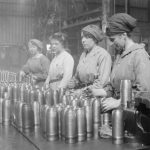 the years that followed the war, from exposure to the same chemicals that had killed the original 400 women.
the years that followed the war, from exposure to the same chemicals that had killed the original 400 women.
As if the dangerous working conditions weren’t enough, women were also paid significantly less than men in comparable positions. In 1918, women workers on London’s buses, trams, and subways organized a strike and managed to win equal pay for equal work. When the war ended, many women were fired to free up jobs for returning veterans. Some thanks that was. I’m sure many of the women were glad to go back to their prior jobs, or go home to take care of their families, but to be fired” was just wrong in every way. Nevertheless, in return for their hard work, these women were fired so that the returning men could have a job again.
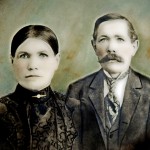 My great grandparents, Carl and Henriette (Hensel) Schumacher immigrated to the United States from Germany, in 1884 and 1882 respectively. It was an amazing time for them. The United States was a whole new world, and for those who came, the land of opportunity. By 1886, they were married and ready to start a family. My grandmother, Anna Schumacher was born in 1887, followed by siblings Albert, Mary (who died before she was 3), Mina, Fred, Bertha, and Elsa, who was born in 1902.
My great grandparents, Carl and Henriette (Hensel) Schumacher immigrated to the United States from Germany, in 1884 and 1882 respectively. It was an amazing time for them. The United States was a whole new world, and for those who came, the land of opportunity. By 1886, they were married and ready to start a family. My grandmother, Anna Schumacher was born in 1887, followed by siblings Albert, Mary (who died before she was 3), Mina, Fred, Bertha, and Elsa, who was born in 1902.
By 1914, World War I broke out, following the assassination of Franz Ferdinand. The government of the United States was understandably nervous about the German immigrants now living in in America. It didn’t matter that many of these people had been living in the united States for a long time, and some had become citizens, married, and had families. The government was still nervous, and I can understand how that could be, because we have the same problem these days with the Muslim nations. Still, when I think about the fact that these were my sweet, kind, and loving, totally Lutheran great grandparents, I find it hard to believe that anyone could be nervous about them. Apparently, I was right, because to my knowledge, they were never detained in any of the internment camps, nor were they even threatened with it.
Nevertheless, there were German nationals, and even naturalized citizens who faced possible detention during 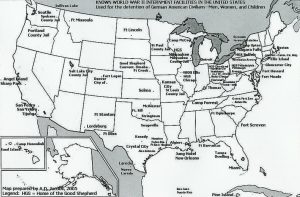 World War I and World War II. By World War II, President Franklin Delano Roosevelt declared Presidential Proclamation 2526, the legal basis for internment under the authority of the Alien and Sedition Acts. With the United States’ entry into World War I, the German nationals were automatically classified as “enemy aliens.” Two of the four main World War I-era internment camps were located in Hot Springs, North Carolina and Fort Oglethorpe, Georgia. Attorney General A. Mitchell Palmer wrote that “All aliens interned by the government are regarded as enemies, and their property is treated accordingly.”
World War I and World War II. By World War II, President Franklin Delano Roosevelt declared Presidential Proclamation 2526, the legal basis for internment under the authority of the Alien and Sedition Acts. With the United States’ entry into World War I, the German nationals were automatically classified as “enemy aliens.” Two of the four main World War I-era internment camps were located in Hot Springs, North Carolina and Fort Oglethorpe, Georgia. Attorney General A. Mitchell Palmer wrote that “All aliens interned by the government are regarded as enemies, and their property is treated accordingly.”
By the time of World War II, the United States had a large population of ethnic Germans. Among residents of the United States in 1940, more than 1.2 million persons had been born in Germany, 5 million had two native-German parents, and 6 million had one native-German parent. Many more had distant German ancestry. With that many people of German ancestry, it seems impossible that they could have detained all of them. Nevertheless, at least 11,000 ethnic Germans, overwhelmingly German nationals were detained during World War II in the United States. The government examined the cases of German nationals individually, and detained relatively few in internment camps run by the Department of Justice, as per its responsibilities under the Alien and Sedition Acts. To a much lesser extent, some ethnic German United States citizens were classified as suspect after due process and also detained. There were also a small proportion of Italian nationals 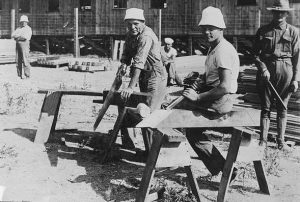 and Italian Americans who were interned in relation to their total population in the United States. The United States had allowed immigrants from both Germany and Italy to become naturalized citizens, which many had done by then. It was much less likely for those people to be detained, if they had already become citizens. In the early 21st century, Congress considered legislation to study treatment of European Americans during World War II, but it did not pass the House of Representatives. Activists and historians have identified certain injustices against these groups. I suppose that some injustices were done, but those were times of war and strong measures were needed.
and Italian Americans who were interned in relation to their total population in the United States. The United States had allowed immigrants from both Germany and Italy to become naturalized citizens, which many had done by then. It was much less likely for those people to be detained, if they had already become citizens. In the early 21st century, Congress considered legislation to study treatment of European Americans during World War II, but it did not pass the House of Representatives. Activists and historians have identified certain injustices against these groups. I suppose that some injustices were done, but those were times of war and strong measures were needed.
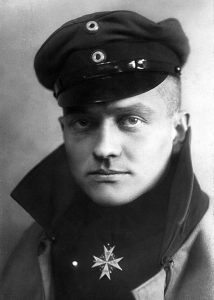 Who fired the shot that killed Richthofen? And who was Richthofen anyway? First, Richthofen was also known as the Red Baron. Manfred Albrecht Freiherr von Richthofen was born on May 2, 1892. He was a fighter pilot with the German Air Force during World War I, and is considered the ace-of-aces of the war. He was officially credited with 80 air combat victories.
Who fired the shot that killed Richthofen? And who was Richthofen anyway? First, Richthofen was also known as the Red Baron. Manfred Albrecht Freiherr von Richthofen was born on May 2, 1892. He was a fighter pilot with the German Air Force during World War I, and is considered the ace-of-aces of the war. He was officially credited with 80 air combat victories.
Nevertheless, as it goes with fighter pilots, their lives are always in jeopardy, and not all of them will come out of war alive. Such was the case with the Red Baron. The end came for him on April 21, 1918. It’s possible that he made mistakes on that final flight. Richthofen was a highly experienced and skilled fighter pilot, who was fully aware of the risk from ground fire. Furthermore, he concurred with the rules of air fighting created by his late mentor Boelcke, who specifically advised pilots not to take unnecessary risks. With that in mind, one must wonder if Richthofen’s judgement during his last combat was unsound or somehow compromised.
Several theories have been proposed to account for his behavior. In 1999, a German medical researcher, Henning Allmers, published an article in the British medical journal The Lancet, suggesting it was likely that brain damage from the head wound Richthofen suffered in July 1917, played a part in the Red Baron’s death. This was supported by a 2004 paper by researchers at the University of Texas. Richthofen’s behavior after his injury was noted as consistent with brain-injured patients, and such an injury could account for his perceived lack of judgement on his final flight…a flight in which he was flying too low over enemy territory and suffering target fixation, which is an attentional phenomenon observed in humans in which an individual becomes so focused on an observed object, that they inadvertently increase their risk of colliding with the object.
Still, the biggest question is not why the Red Baron made the mistake that would get him killed, but rather who killed him. The RAF credited Arthur Roy Brown, an RNAS lieutenant with shooting down the Red Baron, but it is 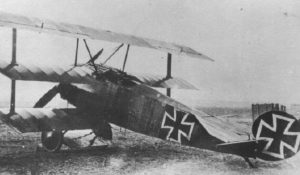 now generally agreed that the bullet that hit the Red Baron was fired from the ground. The Red Baron died following an extremely serious and inevitably fatal chest wound from a single bullet, penetrating from the right armpit and resurfacing from his left chest. Brown’s attack was from behind and above, and from Red Baron’s left. Even more conclusively, Red Baron could not have continued his pursuit for as long as he did…up to two minutes…had this wound come from Brown’s guns. Brown himself never spoke much about what happened that day, claiming, “There is no point in me commenting, as the evidence is already out there.”
now generally agreed that the bullet that hit the Red Baron was fired from the ground. The Red Baron died following an extremely serious and inevitably fatal chest wound from a single bullet, penetrating from the right armpit and resurfacing from his left chest. Brown’s attack was from behind and above, and from Red Baron’s left. Even more conclusively, Red Baron could not have continued his pursuit for as long as he did…up to two minutes…had this wound come from Brown’s guns. Brown himself never spoke much about what happened that day, claiming, “There is no point in me commenting, as the evidence is already out there.”
Many sources, including a 1998 article by Geoffrey Miller, a physician and historian of military medicine, and a 2002 British Channel 4 documentary, have suggested that Sergeant Cedric Popkin was the person most likely to have killed Richthofen. Popkin was an anti-aircraft (AA) machine gunner with the Australian 24th Machine Gun Company, and was using a Vickers gun. He fired at Richthofen’s aircraft on two occasions…first as the Baron was heading straight at his position, and then at long range from the right. Given the nature of Richthofen’s wounds, Popkin was in a position to fire the fatal shot, when the pilot passed him for a second time, on the right. Some confusion has been caused by a letter that Popkin wrote, in 1935, to an Australian official historian. It stated Popkin’s belief that he had fired the fatal shot as Red Baron flew straight at his position. In the latter respect, Popkin was incorrect. The bullet that caused the Baron’s death came from the side.
A 2002 Discovery Channel documentary suggests that Gunner W. J. “Snowy” Evans, a Lewis machine gunner with the 53rd Battery, 14th Field Artillery Brigade, Royal Australian Artillery is likely to have killed Red Baron. 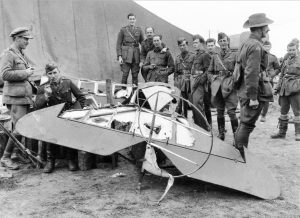 Miller and the Channel 4 documentary dismiss this theory, because of the angle from which Evans fired at Richthofen.
Miller and the Channel 4 documentary dismiss this theory, because of the angle from which Evans fired at Richthofen.
Other sources have suggested that Gunner Robert Buie, also of the 53rd Battery, may have fired the fatal shot. There is little support for this theory. In 2007, a municipality in Sydney recognized Buie as the man who shot down Richthofen, placing a plaque near Buie’s former home. Buie, who died in 1964, has never been officially recognized in any other way. I suppose that, in reality, we will never really know for sure who killed Red Baron, but the theories present an interesting puzzle, and one that will most likely never be solved.

